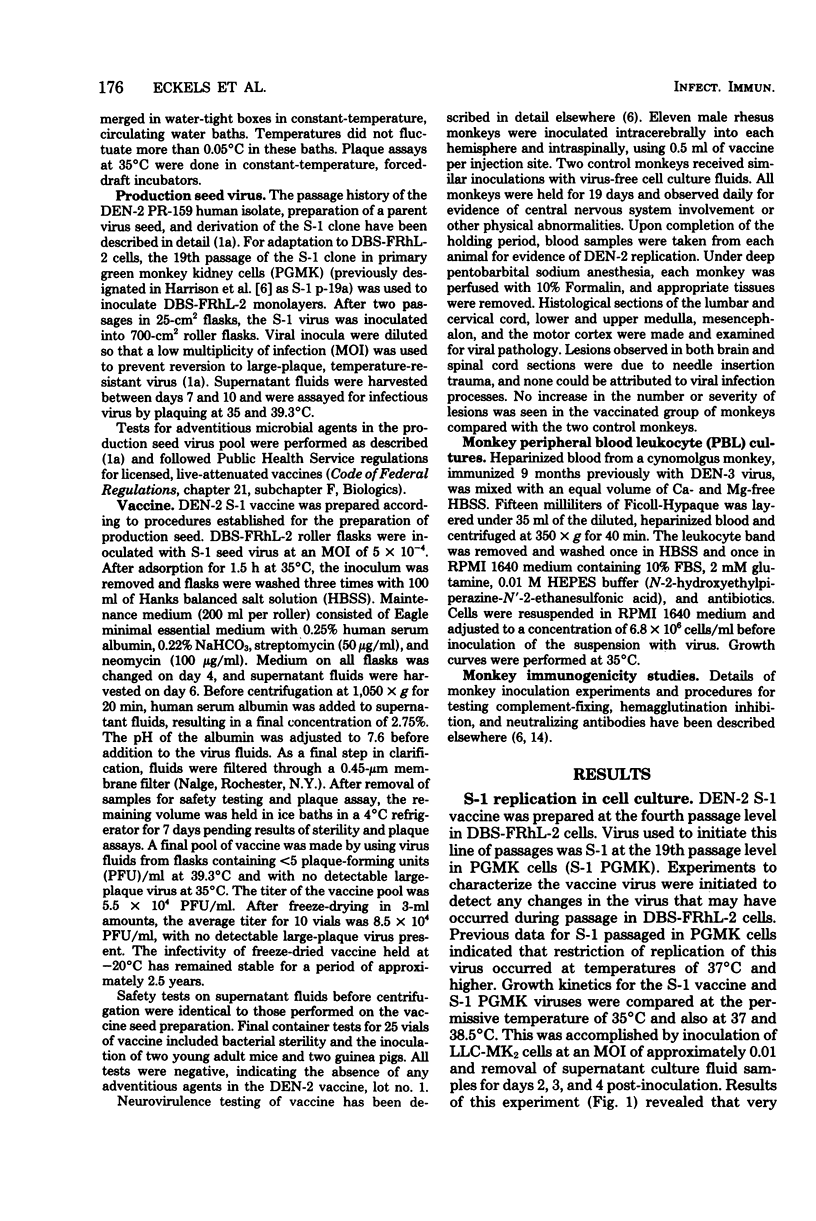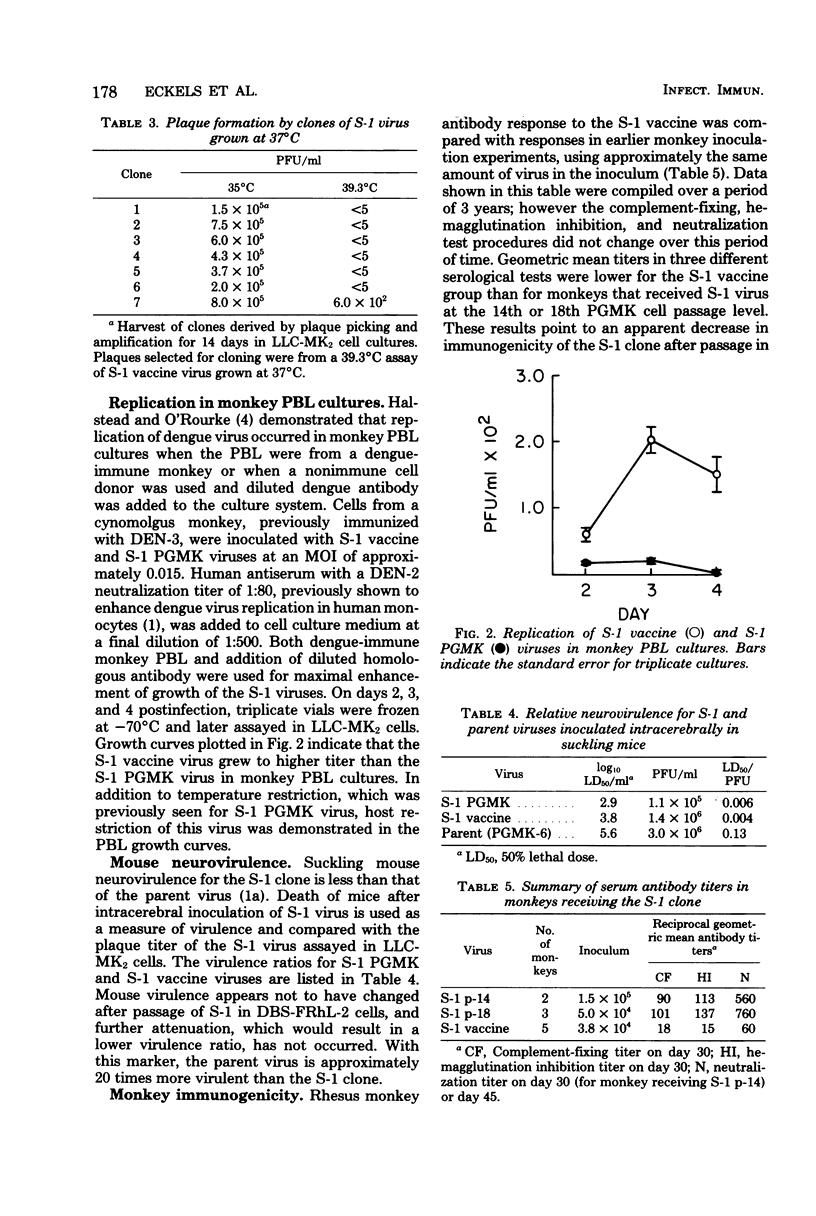Abstract
The S-1 clone of dengue type 2 virus was used for the preparation of a live-attenuated vaccine after passage in DBS-FRhL-2 cell culture. The vaccine virus had a relatively higher replicative capacity at superoptimal temperatures than its precursor virus, S-1, passaged in primary green monkey kidney cells (S-1 PGMK). There was also a tendency for the S-1 vaccine virus to exhibit leakiness at increased temperatures. Another in vitro marker, replication in monkey peripheral blood leukocytes, indicated less host restriction for the S-1 vaccine in comparative assays with S-1 PGMK virus. Mouse virulence appeared to remain stable on passage in DBS-FRhL-2 cells, whereas monkey immunogenicity decreased. Cautious trials of the dengue type 2 S-1 vaccine in humans are indicated.
Full text
PDF





Selected References
These references are in PubMed. This may not be the complete list of references from this article.
- Brandt W. E., McCown J. M., Top F. H., Jr, Bancroft W. H., Russell P. K. Effect of passage history on dengue-2 virus replication in subpopulations of human leukocytes. Infect Immun. 1979 Nov;26(2):534–541. doi: 10.1128/iai.26.2.534-541.1979. [DOI] [PMC free article] [PubMed] [Google Scholar]
- DORRANCE W. R., FRANKEL J. W., GORDON I., PATTERSON P. R., SCHLESINGER R. W., WINTER J. W. Clinical and serologic response of man to immunization with attenuated dengue and yellow fever viruses. J Immunol. 1956 Nov;77(5):352–364. [PubMed] [Google Scholar]
- Eckels K. H., Brandt W. E., Harrison V. R., McCown J. M., Russell P. K. Isolation of a temperature-sensitive dengue-2 virus under conditions suitable for vaccine development. Infect Immun. 1976 Nov;14(5):1221–1227. doi: 10.1128/iai.14.5.1221-1227.1976. [DOI] [PMC free article] [PubMed] [Google Scholar]
- Ehrenkranz N. J., Ventura A. K., Cuadrado R. R., Pond W. L., Porter J. E. Pandemic dengue in Caribbean countries and the southern United States--past, present and potential problems. N Engl J Med. 1971 Dec 23;285(26):1460–1469. doi: 10.1056/NEJM197112232852606. [DOI] [PubMed] [Google Scholar]
- HAMMON W. M., ROHITAYODHIN S., RHIM J. S. STUDIES ON JAPANESE B ENCEPHALITIS VIRUS VACCINES FROM TISSUE CULTURE. IV. PREPARATION AND CHARACTERIZATION OF POOL OF ATTENUATED OCT-541 LINE FOR HUMAN VACCINE TRIAL. J Immunol. 1963 Sep;91:295–305. [PubMed] [Google Scholar]
- HOTTA S. Experimental studies on dengue. I. Isolation, identification and modification of the virus. J Infect Dis. 1952 Jan-Feb;90(1):1–9. doi: 10.1093/infdis/90.1.1. [DOI] [PubMed] [Google Scholar]
- Halle S., Zebovitz E. A spontaneous temperature sensitive mutant of Japanese encephalitis virus: preliminary characterization. Arch Virol. 1977;54(3):165–176. doi: 10.1007/BF01314783. [DOI] [PubMed] [Google Scholar]
- Halstead S. B., O'Rourke E. J. Dengue viruses and mononuclear phagocytes. I. Infection enhancement by non-neutralizing antibody. J Exp Med. 1977 Jul 1;146(1):201–217. doi: 10.1084/jem.146.1.201. [DOI] [PMC free article] [PubMed] [Google Scholar]
- Harrison V. R., Eckels K. H., Sagartz J. W., Russell P. K. Virulence and immunogenicity of a temperature-sensitive dengue-2 virus in lower primates. Infect Immun. 1977 Oct;18(1):151–156. doi: 10.1128/iai.18.1.151-156.1977. [DOI] [PMC free article] [PubMed] [Google Scholar]
- Kelly R. K., Butel J. S. Demonstration of infectious DNA in transformed cells. II. Characterization of uptake of SV40-transformed mouse cell DNA by simian cells. Arch Virol. 1975;48(4):279–287. doi: 10.1007/BF01317426. [DOI] [PubMed] [Google Scholar]
- MAYER V. Two variants of tick-borne encephalitis virus showing different plaque morphology. Virology. 1963 Jun;20:372–373. doi: 10.1016/0042-6822(63)90127-2. [DOI] [PubMed] [Google Scholar]
- Mayer V. The highly attenuated E5"14" plaque-cloned derivative from the Langat TP21 E5 strain. Isolation and properties. Acta Virol. 1973 May;17(3):263–263. [PubMed] [Google Scholar]
- Sabin A. B., Schlesinger R. W. PRODUCTION OF IMMUNITY TO DENGUE WITH VIRUS MODIFIED BY PROPAGATION IN MICE. Science. 1945 Jun 22;101(2634):640–642. doi: 10.1126/science.101.2634.640. [DOI] [PubMed] [Google Scholar]
- Scott R. M., Nisalak A., Eckels K. H., Tingpalapong M., Harrison V. R., Gould D. J., Chapple F. E., Russell P. K. Dengue-2 vaccine: viremia and immune responses in rhesus monkeys. Infect Immun. 1980 Jan;27(1):181–186. doi: 10.1128/iai.27.1.181-186.1980. [DOI] [PMC free article] [PubMed] [Google Scholar]
- Tarr G. C., Lubiniecki A. S. Chemically induced temperature-sensitive mutants of dengue virus type 2: comparison of temperature sensitivity in vitro with infectivity suckling mice, hamsters, and rhesus monkeys. Infect Immun. 1976 Mar;13(3):688–695. doi: 10.1128/iai.13.3.688-695.1976. [DOI] [PMC free article] [PubMed] [Google Scholar]
- Wallace R. E., Vasington P. J., Petricciani J. C., Hopps H. E., Lorenz D. E., Kadanka Z. Development of a diploid cell line from fetal rhesus monkey lung for virus vaccine production. In Vitro. 1973 Mar-Apr;8(5):323–332. doi: 10.1007/BF02619056. [DOI] [PubMed] [Google Scholar]


